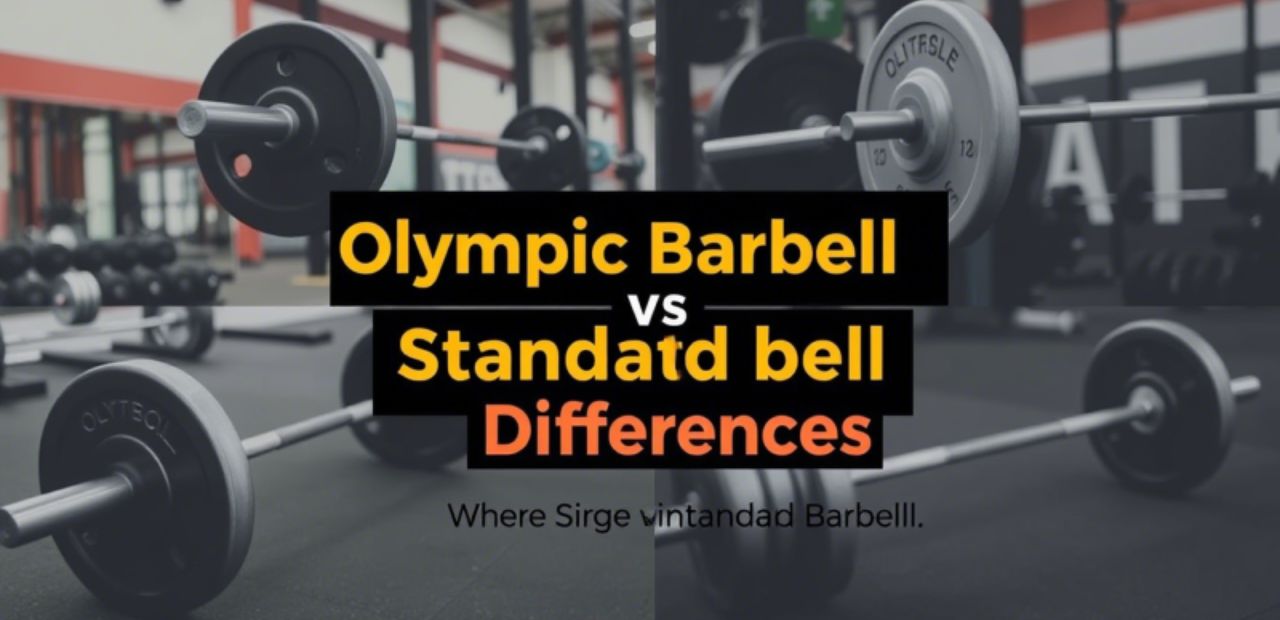When it comes to weightlifting, choosing the right equipment is essential for both performance and safety. Two of the most commonly used barbells are the Olympic barbell and the standard barbell. But what are the key differences between the two? In this article, we’ll explore the 7 critical Olympic barbell vs standard barbell differences, helping you make an informed decision on which barbell is best suited for your fitness goals.
Size and Weight: Olympic Barbells Are Heavier
One of the most obvious differences between Olympic and standard barbells is their size and weight. An Olympic barbell typically weighs 20 kilograms (44 lbs) for men and 15 kilograms (33 lbs) for women, while a standard barbell usually weighs around 14-20 kilograms (30-44 lbs), depending on the material and design.
The Olympic barbell’s heavier weight is beneficial for advanced lifters or athletes focused on powerlifting or Olympic weightlifting. In contrast, the standard barbell is often lighter and may be more suitable for beginners or general fitness training.
Length and Grip: Olympic Barbells Are Longer
The Olympic barbell measures about 7 feet (2.2 meters) in length, providing more space for wider grip techniques, which is ideal for Olympic lifts like the snatch or clean and jerk. The standard barbell, however, is typically shorter, around 5-6 feet in length, making it more compact and easier to use for exercises like bench presses, squats, and deadlifts.
Additionally, the Olympic barbell comes with a knurled grip that is designed to offer better control, especially during dynamic lifts.
Diameter: Olympic Barbells Have Larger Sleeves
A critical difference between Olympic and standard barbells lies in the diameter of the sleeves (the part of the barbell where you load the weights). Olympic barbells feature larger sleeves, typically 2 inches (50mm) in diameter, which are designed to accommodate Olympic weight plates. Standard barbells, on the other hand, have a 1-inch (25mm) diameter, meaning they’re compatible with standard weight plates that are smaller.
If you plan on using Olympic weight plates, then an Olympic barbell is necessary. Conversely, if you already have standard weight plates, a standard barbell is a more economical choice.
Barbell Flexibility: Olympic Barbells Are More Flexible
One of the distinguishing features of Olympic barbells is their flexibility. They are built to bend (or “whip”) during lifts like the clean and jerk, which requires the barbell to flex and return to its original position. This flexibility allows athletes to perform more dynamic movements with precision and control.
In comparison, standard barbells are much stiffer and less flexible, making them better suited for stationary exercises such as bench presses, squats, and deadlifts, where flexibility is less of a concern.
Loadable Weight Capacity: Olympic Barbells Can Handle More Weight
Olympic barbells are designed to handle heavier loads compared to standard barbells. Most Olympic barbells can hold up to 1,000 pounds (450 kg), making them ideal for advanced weightlifters who need to lift heavy loads for squats, deadlifts, and Olympic lifts.
Standard barbells, while sturdy, typically have a lower weight capacity (around 300-500 pounds), making them more suitable for general fitness enthusiasts or those who do not plan to lift ultra-heavy weights regularly.
Construction and Durability: Olympic Barbells Are More Durable
Olympic barbells are typically made from high-quality steel and are designed for maximum durability and long-lasting use. They are built to withstand the stresses of heavy lifting and are often plated with chrome or zinc to prevent rust.
On the other hand, standard barbells are often made with lower-grade materials, which can lead to wear and tear over time, especially when heavy weights are frequently loaded and unloaded.
Price: Olympic Barbells Are More Expensive
Due to their construction, materials, and design, Olympic barbells tend to be more expensive than standard barbells. The cost of an Olympic barbell can range anywhere from $150 to $400 or more, depending on the brand and quality.
Standard barbells, however, are generally more affordable, with prices starting at $50 and going up to $150. While Olympic barbells come with many advantages in terms of capacity and performance, standard barbells can offer a cost-effective option for home gyms or casual lifters.
Conclusion: Which Barbell Is Right for You?
In summary, the decision between an Olympic barbell vs standard barbell comes down to your personal fitness goals and budget. If you’re serious about Olympic lifting, powerlifting, or training with heavier weights, an Olympic barbell is the way to go. However, if you’re a beginner or you’re working with a limited budget, a standard barbell may suit your needs perfectly.
No matter which barbell you choose, it’s important to ensure that your equipment supports your long-term training goals. Whether you’re lifting for strength, fitness, or competition, using the right barbell can make all the difference in your workout performance and progress.

Emily Rose Johnson is a passionate writer with a knack for crafting engaging content. She specializes in communication strategies, digital marketing, and creative storytelling.









